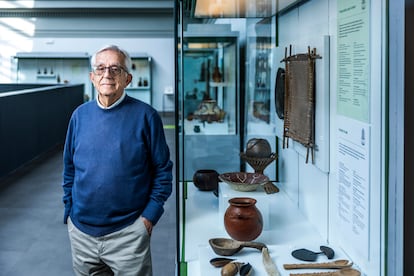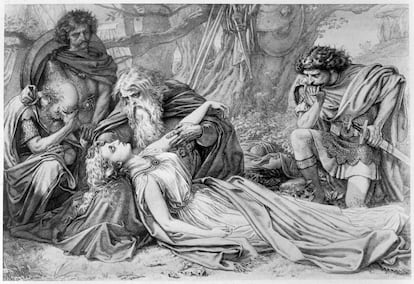Antonio Rodríguez Almodóvar (Alcalá de Guadaíra, 83 years old) one day started looking for kings, princesses, witches, giants, wolves, audacious jesters: inhabitants of the mind. He toured Andalusia, starting in 1976, in search of the popular tales that resisted the collective intellect. He sniffed around the towns, pulled strings, asked town halls, got informants… “They always sent me to unusual places,” he remembers. They were the people from below, peasants, shepherds, ranchers, many of them illiterate. They were unaware that their stories were strongly embedded in human culture for thousands of years. Thus the philologist was recovering the oral heritage of traditional narratives, in the many and varied versions that flourish from each story.
His love for stories comes from reading the Juan de Mairena by Antonio Machado, where a strong defense of folklore is made. And he came to this book through the famous anarchist professor Agustín García Calvo. “I had the immense luck to be his student in Seville,” says Almodóvar, who also, in the process, became an expert on Machado. In 2006 a new campaign began, accessing informants in other territories such as Euskadi, Asturias or Catalonia. He compiled 76 hours of recordings, which he donated to the Museum of Popular Art and Customs in Seville. “A very old Biscayan peasant woman from the deep rural world told me an ancient version of As the food loves saltwhich is the story on which the Rey Lear of Shakespeare,” says the expert. “I almost fell off my chair.”
40 years have passed since Almodóvar published the first volume of his compilations and studies of popular stories, of a structuralist nature, which then achieved great success. Now the publishing house Alianza releases a compendium of those works, under the title Stories about the love of the firewhich brings together wonderful stories, stories of customs and stories of animals.
“Before, it was 20 years ago… now 40 have passed,” jokes the author, who has chosen to do the interview at the National Museum of Anthropology, in Madrid, for obvious reasons. “Coming out of the dictatorship there was a great desire for everything authentic, people were tired of censorship, there was a desire to know. The stories touched the sensitive chord of our childhood, we did a great group therapy of the collective unconscious,” he remembers. Now he fights to maintain the stories, so that they are not lost, when they are not at their best.
They are stories like The Kiriko Rooster, The half chick, John the bear, Blancaflor, The shepherd and the princess, The grateful animals and a very long etcetera. A precedent was the Spanish folk talesa pioneering compilation by Aurelio Macedonio Espinosa, an American, professor at Stanford University, who on a trip to Spain collected 302 stories. They were published in 1923: Almodóvar’s work can be considered a descendant. “Espinosa discovers that the lullabies were brought by the maids, which is why Machado, in the Juan de Mairenasays that we must take care of popular folklore, because it is what, through the maids, educates the wealthy classes,” says Almodóvar, who, by the way, has been active in socialism, being deputy mayor in Seville or director general in the Andalusian Ministry of Education. He is a corresponding member of the Royal Academy of Language in his homeland and has won the National Prize for Children’s and Young People’s Literature.
The pedagogy of folklore
Children have traditionally grown up surrounded by folklore pedagogy, which provides keys to many aspects of life. These keys, Almodóvar says, are transmitted through stories, which, in their symbolic nature, provide the mental scaffolding to understand the world. Popular narratives help generate systems of binary categories (good/evil, hero/villain, reward/punishment) that allow the world to be organized in an understandable way. The stories cover “needs of the mind,” in the expert’s words. They are ancestral stories, which can be thousands of years old, that migrate from culture to culture, adapting and mutating, but maintaining an essence that can be traced.

Just as different clocks contain the same clockwork, the Russian linguist and anthropologist Vladimir Propp discovered that all wonderful stories are made up of 31 functions, or narrative steps: the departure from the house, the transgression of the forbidden, the reception of an object magical, returning home incognito (like Ulysses to Ithaca), etc. Not all stories have all of them, but they all have some combination of those 31.
The American mythologist Joseph Campbell noted something similar when he established the hero’s journeya series of steps (the call to adventure, the meeting with the master, the reward for actions, etc.), found from the Epic of Gilgameshthe oldest known story, to Star Wars (George Lucas consciously used this structure in the creation of his personal and spatial mythology), and it has even inspired Alana Portero’s successful novel, bad education (Seix Barral). These series of steps are a reflection of our psyche and help us understand the world and human adventures. They reflect our fears and desires and show us models to follow. “And all written cultures, as Propp said, are born from oral folklore,” explains the expert.
Indo-European origin
John the bearpresent in Europe, Latin America or Asia, is one of the oldest and, in Almodóvar’s opinion, most interesting stories. A peasant woman from Carmona, Seville, told him this in the 70s. Juan is born of a woman and a bear, with extraordinary strength, and contains several fundamental steps of mythical tales and stories: the hero of special and wild origin, the murder of his father, the journey full of trials that he overcomes with the help of allies, magical objects or supernatural events.
The philologist defends the Indo-European origin of these stories, which can be found in northern India as well as in Western Europe (for example, stories similar to Cinderella, which are also found in China or the Arab world), and dates them back to the Neolithic Revolution, about 10,000 years ago, when, after the development of agriculture, societies became sedentary. From communal property, characteristic of archaic societies, private property arises and power hierarchies are established.

“That is when we get into the enormous mess that we have not yet gotten out of: that of society divided between the poor and the rich,” says Almodóvar. In these tales the king often symbolizes an old owner who has problems bequeathing his property (as seen in king lear and the struggle of his three daughters). Many stories deal with private property and inheritance, or address the struggle for power, resources, or status within the social structure. See The brave little tailor o Puss in boots: The humble person is usually smarter than the dominant one and social promotion is achieved thanks to cunning. Everything very neolithic, everything very current.
“The stories symbolically raise the divided society as something debatable,” says the author, “they already warn that the concentration of property can have perverse effects.” This is still seen, thousands of years later, in the housing problem. “We are nostalgic for the forest, for the previous stage, when we were hunter-gatherers and everything belonged to everyone,” says Almodóvar.
A criticism that can be made of popular stories, and that is made, is that they can be cruel, sexist, or both at the same time. In 2019, a school in Barcelona removed 200 children’s stories from its library because it considered them “toxic” to children’s minds; between them Little Red Riding Hood o sleeping beauty. They accounted for 30% of the story collection. The remaining 60% were considered suitable, and only 10% written from a gender perspective. Although, if the stories have been adapted to different times and cultures, they should not find a problem finding their place in this one either. “It is true that there can be cruelty in stories, but it can be minimized. The stories evolve by themselves and adapt to the times,” concludes Almodóvar.

